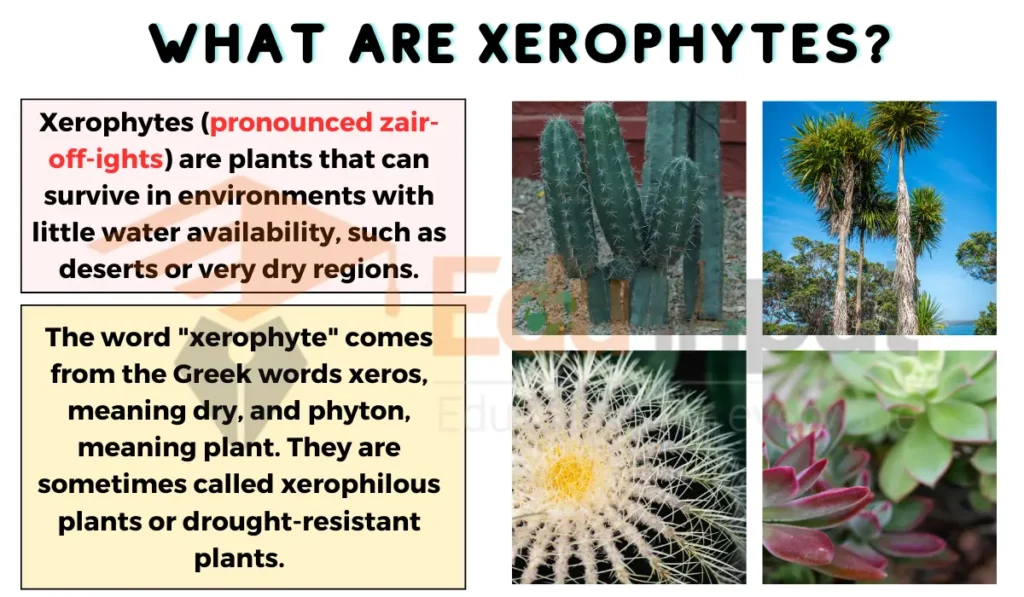Xerophytes-Definition, Charectristics, Taxonomy, and Habitat
Xerophytes Definition
Xerophytes (pronounced zair-off-ights) are plants that can survive in environments with little to zero water availability, such as deserts or very dry regions.
The word “xerophyte” comes from the Greek words xeros, meaning dry, and phyton, meaning plant. They are sometimes called xerophilous plants or drought-resistant plants.

Characteristics of Xerophytes
Some of the common characteristics and features of drought-resistant plants include:

- Extensive, deep roots tapping into deeper moisture reserves.
- Shallow, wide-spreading roots capturing fleeting soil surface moisture.
- Few or no root hairs to minimize water loss.
- Fine, branched roots maximizing soil contact.
- Responsive root growth towards detected moisture.
- Succulent stems and leaves storing water.
- Small leaves reducing surface area and transpiration.
- Deciduous leaves shed during dry seasons.
- Needle-like or rolled leaves presenting minimal surface area.
- Thick cuticles minimizing water evaporation from leaves.
- Sunken stomata hidden beneath surfaces or within pits.
- Leaf hairs and thorns creating a still air boundary around leaves.
- Vertical leaf orientation minimizing sun exposure and heat.
- Paraheliotropic movements tracking the sun to avoid direct radiation.
- Crassulacean Acid Metabolism (CAM) reducing water loss during photosynthesis.
- Soft parenchyma tissue throughout the plant for water storage.
- Shedding of plant parts like leaves, bark, and even fruits to conserve moisture.
- Early flowering and seed production ensuring reproduction before drought.
- Dormant seeds viable for years through dry periods.
- Dieback of above-ground parts with perennating buds surviving below ground for regeneration.
Also Read: Methods of Osmoregulation in Plants
Xerophyte Habitat
Xerophytes can be found in a variety of arid and semi-arid environments around the globe. Here are some of their typical locations:
Hot Deserts
- Sahara – Sahara Desert in North Africa is home to numerous xerophytes like succulents, cacti, and spiny shrubs.
- Kalahari Desert – Located in southern Africa, the Kalahari boasts iconic baobab trees, succulents, and drought-resistant grasses.
- Australian Outback – The scorching temperatures and limited rainfall of the Australian Outback make it ideal for spinifex grasses, acacias, and bottlebrush trees.
- Sonoran Desert – Spanning parts of Mexico and the US Southwest, the Sonoran Desert showcases saguaro cacti, Joshua trees, and creosote bushes.
Cold Deserts
- Great Basin Desert – Stretching across parts of the US, the Great Basin Desert features sagebrush, shadscale, and pinyon pines. (Do you know Why Are Pines Xerophytes?)
- Gobi Desert – Encompassing parts of Mongolia and China, the Gobi Desert is home to saxaul trees, sand lilies, and drought-resistant grasses.
- Patagonian Desert – Found in southern tip of South America, the Patagonian Desert is known for its thorny shrubs, cacti, and saltbush.
Other Arid Regions
- Mediterranean climates – These areas with wet winters and dry summers offer habitats for xerophytes like olive trees, rosemary, and lavender.
- Coastal sand dunes – The harsh conditions of coastal dunes are tackled by xerophytes like beach grasses, seagrasses, and succulents.
- Rocky outcrops and slopes – These dry, sun-exposed areas are often colonized by xerophytes like yuccas, cacti, and succulents.
Classification of Xerophytes
There are two categories of plants with drought adaptations:

- True xerophytes – plants that occur exclusively in areas with moisture deficiency, e.g. cacti, euphorbs.
- Drought-resistant plants – plants that can thrive in mesic conditions, but also have traits that confer drought resistance, e.g. cinnamon fern.
Major Taxa Containing Xerophytic Species
Xerophytes span a wide range of plant families and genera. Some major taxa containing xerophytic species include:
- Cactaceae – The cactus family, including saguaro, prickly pear, and cholla cacti. Over 90% of cacti are xerophytes.
- Euphorbiaceae – The spurge family, including crown of thorns and poinsettia. Half of euphorbs are xerophytic.
- Agavaceae – The agave family, including the Joshua tree. Many agaves thrive in arid environments.
- Asteraceae – The sunflower/daisy family. Desert species include brittlebush and desert zinnia.
- Didiereaceae – A family of succulent, spiny shrubs from Madagascar with water storage capabilities.
- Bromeliaceae – Several bromeliads are xerophytic, like Spanish moss air plants.
Major Xerophyte Plant Groups
Beyond plant families, xerophytes also fall into some broad morphological groups with shared adaptations:
- Succulents – Plants with fleshy water storage organs, like agaves, aloes, jade plants and cacti.
- Bulbs & other geophytes – Plants that reside dormant underground during drought as bulbs, tubers, corms etc., like crocus and narcissus.
- Trees and shrubs with tiny / highly adapted leaves (xeromorphic) – Small waxy leaves, thorns instead of leaves, deciduous leaves, etc. Creosote bush is a prime North American example.
- Grasses and herbs with extensive root systems – Many desert wildflowers and prairie plants.
- Carnivorous plants – Traps like sticky mucilage allow them to extract moisture from prey since they grow in moisture-deficient mineral-deficient soils. Examples include sundews and Venus fly traps.
- Epiphytes – Tropical plants that grow non-parasitically on other plants, like orchids, ferns and bromeliads. They absorb water and nutrients from humid air and rain since they lack contact with the ground.
Read Xerophytes Examples
How Xerophytes Are Adapted To Their Habitat?
Xerophytes survive in dry environments through a variety of physiological and morphological adaptations. Deep roots tap into hidden water reserves, while small leaves and waxy coatings minimize evaporation. Water storage tissues and efficient metabolic pathways like CAM photosynthesis further conserve moisture.
Read How Do Xerophytes Perform Photosynthesis
Xerophytes have evolved both physically and physiologically to conserve water, store water when available, reduce water loss and withstand prolonged periods of drought. Their adaptations help them capture precious moisture from the air and soil and use it in the most efficient manner possible.
Many xerophytes exhibit succulence, the ability to store water in fleshy stems, leaves, or roots. Others have small, thick leaves with waxy coatings to retard moisture loss. Still others have extensive root systems that spread out wide and deep to absorb water from a large area.
Also Read:
Difference Between Mesophytes and Xerophytes



Leave a Reply